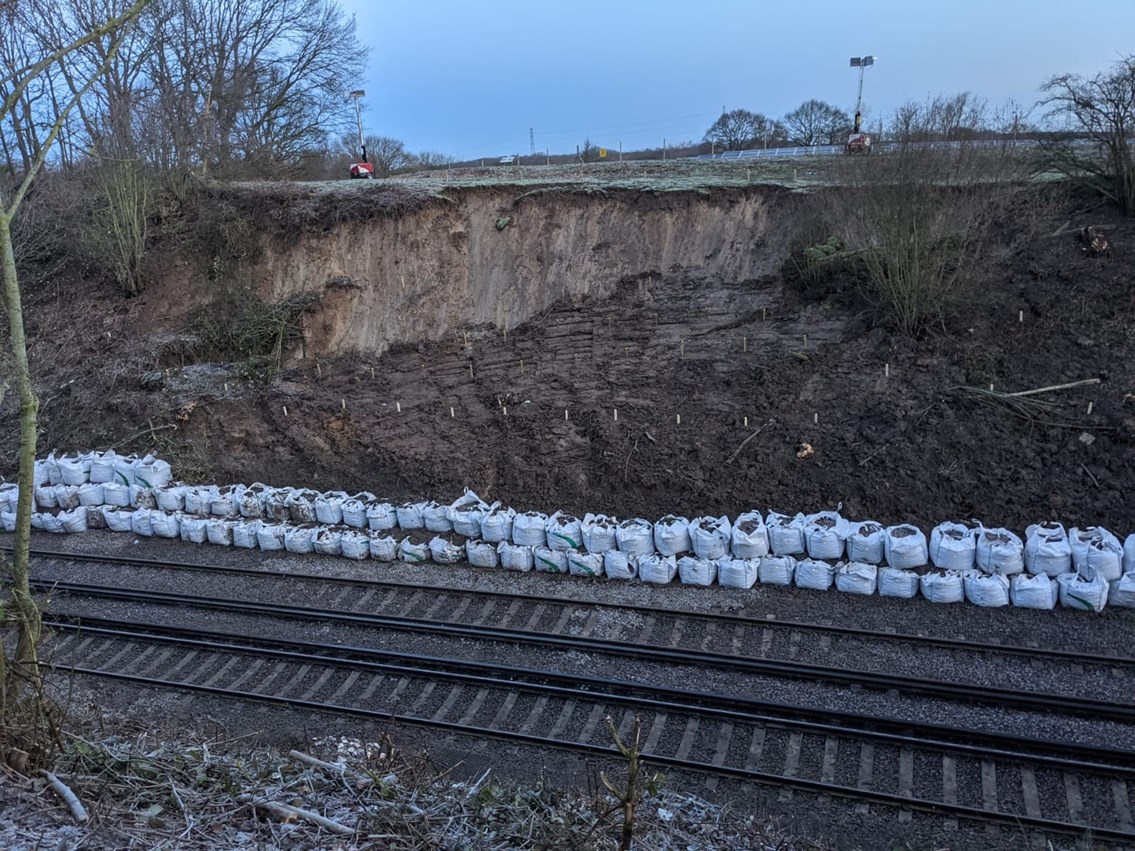Friday 22 Jan 2021
Railway to close for 15 days between Sittingbourne and Gillingham, as Network Rail engineers tackle 40 metre landslip
- Region & Route:
- Southern: Kent
- | Southern
Network Rail engineers are preparing to tackle a 40 metre-long landslip that blocked the line at Newington, near Sittingbourne, earlier this week, with work set to begin on Sunday (24 January).
The slip closed the railway on Wednesday and Thursday, while a temporary fix was put in place to allow the line to open for two days. However, the scale of the problem meant a permanent solution had to be put in place as soon as possible, with design work, staff and equipment mobilisation already underway today (Friday).
The line will close from the last train on Saturday night (23 January) until the first train on Monday, 8 February. This will mean no Southeastern trains will be able to run between Gillingham and Sittingbourne and Thameslink trains from London to Rainham will terminate one station early, at Gillingham. A bus replacement service will be provided.
Network Rail’s route director for Kent, Fiona Taylor, said: “This has been a difficult week for passengers on the railway through Newington and I’m really sorry we’ve had to take this drastic action so soon after reopening it. We’ve kept trains safe throughout the week but we don’t want to cause any more disruption and the best way to achieve that is to close the railway and rebuild it.
“It’s not an easy decision but the scale of this problem means there’s no way of fixing it without stopping trains and the sooner we do that, the sooner this line can open safely again. I'd really like to thank our passengers for their patience in these difficult times.”
Southeastern’s Train Services Director, Scott Brightwell, said: “There is never an ideal time to close the railway but this work by Network Rail is essential to ensure that this stretch of track can reopen for trains as soon as possible, allowing passengers’ journeys to continue without delay. We’ll make sure that changes to journey times and details of replacement bus services are well communicated through our website, National Rail Enquiries, and through our Twitter account @Se_Railway, so please check before you travel.”
Jenny Saunders, Customer Services Director for Thameslink, added: “Due to Government restrictions, you should only be travelling if your journey is absolutely essential. I'm sorry to our Thameslink passengers affected by this work - please make sure you check the latest travel advice before setting out.”
The slip occurred on a section of railway built in 1858, where the line is cut 13m deep into the surrounding hill. After days of heavy rain, the top section of the cutting side gave way and slowly slipped downhill towards the track. Over 300 tons of spoil was removed before the line could be reopened and there’s still more to go.
The line is currently protected with a series of 1-ton bags of stone, which will be replaced with a 60 metre wall of 12m steel sheet piles, sunk into the ground.
Notes to Editors
*Although the landslip is between Rainham and Sittingbourne, shutting the power to the live rail off through the area is not possible without including Rainham, so Thameslink trains will be unable to draw power and will be turning round at Gillingham. If it becomes possible to change this later in the week, we will do so.
Contact information
Passengers / community members
Network Rail national helpline
03457 11 41 41
Latest travel advice
Please visit National Rail Enquiries
Journalists
Network Rail press office - Chris Denham
Operational Communications Manager
020 3357 7969
07515 626530
chris.denham@networkrail.co.uk
About Network Rail
We own, operate and develop Britain's railway infrastructure; that's 20,000 miles of track, 30,000 bridges, tunnels and viaducts and the thousands of signals, level crossings and stations. We run 20 of the UK's largest stations while all the others, over 2,500, are run by the country's train operating companies.
Usually, there are almost five million journeys made in the UK and over 600 freight trains run on the network. People depend on Britain's railway for their daily commute, to visit friends and loved ones and to get them home safe every day. Our role is to deliver a safe and reliable railway, so we carefully manage and deliver thousands of projects every year that form part of the multi-billion pound Railway Upgrade Plan, to grow and expand the nation's railway network to respond to the tremendous growth and demand the railway has experienced - a doubling of passenger journeys over the past 20 years.
Follow us on Twitter: @networkrail
Visit our online newsroom: www.networkrailmediacentre.co.uk

